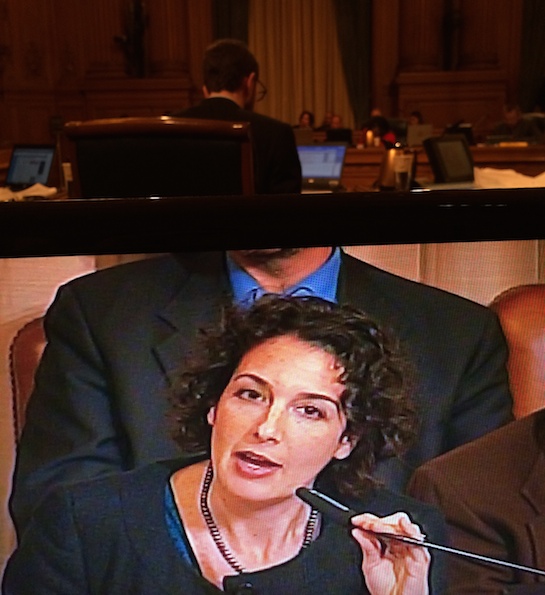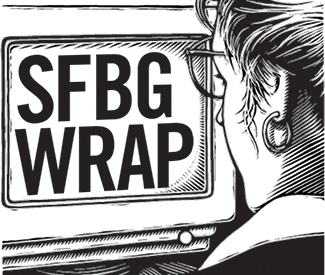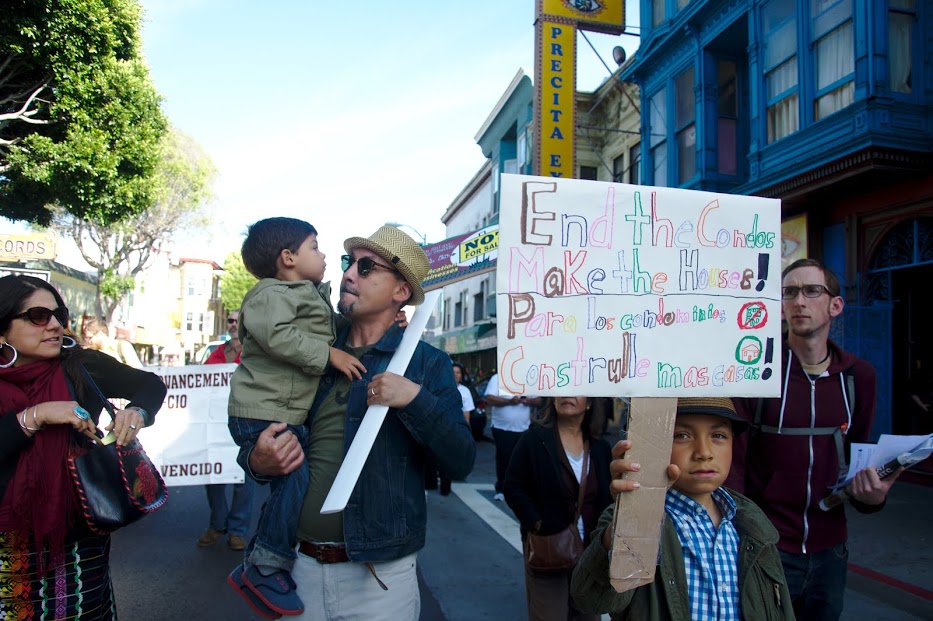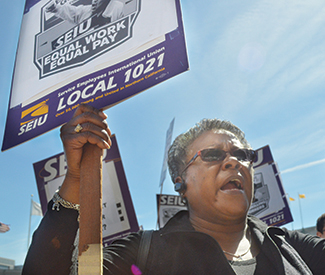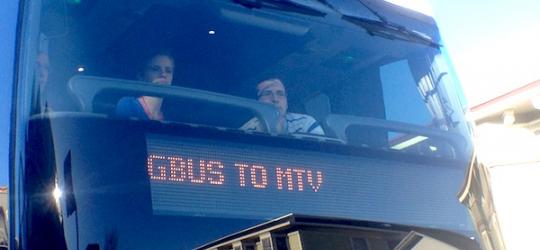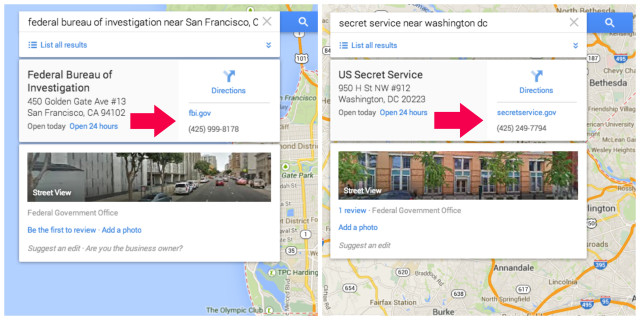joe@sfbg.com
At the San Francisco Board of Supervisors on April 1, an environmental appeal hearing on the San Francisco Municipal Transportation Agency’s commuter shuttle pilot program elevated the so-called Google Bus into a powerful symbol with two narratives — of gentrification and displacement, or the misguided belief that tech workers are to blame for those trends in San Francisco.
Those weren’t the only divergent tales to emerge at the seven-hour long, emotion-packed hearing. While the buses were praised as good alternatives to San Franciscans driving to work in the Silicon Valley, there was also a surprising level of consensus that they’re causing conflicts at local bus stops and need to be better regulated by the SFMTA.
The tale of the Google Bus as told by the tech industry is this: the buses ferry the workers of a bourgeoning economic sector in a city that now leads the world in innovation. At its most basic, the Google Bus reduces wasteful driving, an environmental boon to the region.
But activists decrying displacement have beaten down a Google Bus effigy in the form of a piñata, and the morning before the hearing, protesters in clown costumes blockaded another Google Bus. Their tale of the Google Bus is about monstrous private transports that hurt low-income San Franciscans by clogging up Muni stops and driving up the price of nearby housing.
Protesters dressed as clowns blockade a Google bus the day the CEQA hearing was held.
In this increasingly economically polarized city, A Tale of Two Cities is oft-mentioned in progressive political circles. But now A Tale of Two Google Buses has become the story of the moment, a story whose moral depends on one’s perspective.
SILENT ON SHUTTLES
Carli Paine, who manages this and other pilot programs at the SFMTA, listened to over an hour’s worth of public complaints about the shuttles at the hearing before enduring a tough grilling by Sup. David Campos and others.
“I don’t have a problem with tech workers, but the arrogance of the tech companies,” a woman who identified herself as a nurse said at public comment. “I’m on the Muni bus that’s packed to the gills that’s held up behind a Google bus.”
Paine has heard many variations on that since the Google buses arrived six years ago. The shuttles blocked Muni buses, held up traffic, and blocked bike lanes, but Paine said the SFMTA’s early efforts to cite buses for illegally using Muni stops weren’t working.
“That’s not a comprehensive policy,” she told us in a phone interview after the hearing. “It’s reactionary. We recognized we needed a policy to address commuter shuttles.”
In 2010, the SFMTA applied for grants to measure shuttle impacts, receiving funding in 2011. The first step was to go to the tech companies — Google, Facebook, Yahoo and their ilk — to get the data. The questions were basic, asking for counts: the number of shuttles, stops, riders, and trips. The tech industry flatly ignored SFMTA’s inquiries.
“Some data was private, they felt,” Paine said. “One of the reasons we’re doing the pilot is there’s information we haven’t been successful in getting voluntarily.”
Tech companies were incommunicado at the hearing as well. Hundreds of people, from technology workers to activists to everyday San Franciscans showed up, but representatives of the technology sector did not announce themselves.
“I think it’s worth pointing out how absent the tech companies are,” Sup. Malia Cohen said at the hearing, contrasting that with three years ago, when Twitter and other companies sought city tax breaks. “The tech executives were swarming City Hall.”
That night, the public finally got a peek at the fruits of Paine’s research. The Budget and Legislative Analyst Office released a report aggregating data from many sources, including the SFMTA. The findings tell the story of the damage caused by commuter shuttles on city streets.
BIG BAD BUSES
The BLA’s report makes one thing clear: while the commuter shuttle plot program applies to all privately owned shuttles, the main public debate is directed at regional shuttle buses ferrying workers to Silicon Valley.
The BLA estimates there are 131 regional shuttles with 8,030 boardings (to San Francisco and back) per a day. Of the shuttles making 273 trips to and from San Francisco daily, the lion’s share (57) are owned by Google. Its workers represent just over half of daily boardings.
The invading buses are also enormous. Taller than a Muni bus, the BLA reports that the Google buses weigh 31 tons when fully loaded, nearly twice the weight of a big rig truck. That’s also a far cry from the seven-ton intra-city shuttles used by the likes of the Academy of Art University and Kaiser Permanente. That size comes with a cost.
“The Department of Public Works staff concur that heavier vehicles contribute to faster roadway deterioration,” the BLA wrote. The damage a shuttle makes on the pavement with a single trip accounts for $1.08 out of the $1 million it will ultimately cost the city to reconstruct a mile of pavement. A typical personal car will cause $0.00023 of damage to pavement over its entire lifetime. So one shuttle trip is “equivalent to 4,700 passenger vehicles driving over the same lane.”
But the city isn’t allowed to charge for that damage. The SFMTA is precluded from charging a fee for road damage pursuant to California Vehicle Code, the BLA report wrote, which restricts local governments for taxing use of city streets.
The SFMTA could opt to collect money by fining shuttle scofflaws. The BLA reports that, “half of the known stops” for all private shuttles take place in Muni bus zones, which is against city law — stops can only be made in white zones, and Muni stops are striped red.
“These are pirate shuttles,” said Richard Drury, the attorney who appealed the program on behalf of the SEIU Local 1021 and other appellants. “They are illegal.”
But at the hearing, the BLA reported that of 13,085 citations made to vehicles in red zones since January 2014, only 45 were issued to commuter shuttles. Campos fired verbal salvos at Paine and SFMTA Director Ed Reiskin, demanding to know why red zone parking laws weren’t enforced.
“Was there a policy not to cite the buses?” Campos asked, pointedly, to which Reiskin replied, “There was not.”
SFMTA dir. Ed Reiskin answers the $1 million question: Out of 13,000 traffic citations, why only 45 to #googlebus? pic.twitter.com/Od8IaibL4A
— Joe Fitz Rodriguez (@FitzTheReporter) April 2, 2014
But in an email obtained by Tim Redmond of 48Hills.org (and formerly of the Bay Guardian), a vice president at Bauer (a shuttle provider contracting with tech companies) wrote to Paine in January asking her to dismiss its shuttle citations. “As I assume you know, we have had a ‘handshake’ agreement with SFMTA for many years that allowed us to use stops under a ‘Muni First’ condition.”
Paine refused to comment on whether the shuttles had permission to use the stops. But the practice of using them has definitely had an impact on the cost of nearby housing as tech employees pay top dollar for the convenience.
HOUSING BOOMLETS
From 2010 to 2012, San Francisco’s population increased by more than 20,000, the BLA reported, and consequently, “The demand for housing has increased.”
“We’re bussing wealthy, predominantly white adults into low-income neighborhoods, where they in turn displace low-income people,” Drury said at the hearing. “This is the reverse of affirmative action.”
The BLA cites multiple studies demonstrating a spike in rental prices immediately around the shuttle stops. On Lombard in the Marina, rents soared by 30 percent near the shuttle stops, as opposed to 17 percent in the rest of the neighborhood. Near the Dolores Street shuttle stops, rents soared by 43 percent, as opposed to 23 percent just a few blocks away.
Even a cursory search of Craigslist shows higher rents at listings that advertise “easy access for commuters and 10 minutes to Apple/Google/Yahoo shuttle bus stops!”
I drew the #PirateShuttle because somebody had to. #Googlebus #CEQA pic.twitter.com/WrrbdYzODR
— Julia Wong (@juliacarriew) April 2, 2014
The BLA admits this anecdotal evidence doesn’t “show causation.” But at the hearing, a tech worker named Martin MacKerel pleaded with his colleagues to recognize the shuttles may hurt San Franciscans, despite the industry’s best intentions.
“I’m here to talk to my fellow tech workers here,” he said. “We’ve got to consider that we’re displacing people into Antioch, San Pablo, the East Bay. If they have to drive in to San Francisco, we need to know that.”
Tech worker Andrew Textor delivered a different message at the hearing, decrying the villainization of tech workers.
“I’ve lived in the city for 10 years, I’ve been riding the shuttles four and a half,” he said. “Please let this program go forward. I’m not a new arrival, I don’t like being called ‘techie.’ I’m still a San Franciscan.”
In the Tale of Two Google Buses, the shuttles are symbols of populist anger and economic frustration, but also real vehicles that harm San Francisco in ways that can be measured and regulated, which officials claim the 18-month pilot program will do. The supervisors denied the environmental appeal on an 8-2 vote.
“We don’t want to stop the buses,” Cynthia Crews of the League of Pissed Off Voters said at the hearing. “We just want the companies to pay their fair share.”
Tech worker Andrew Textor “I’m not a new arrival, I don’t like being called ‘techie.’ I’m still a San Franciscan.” pic.twitter.com/sq3kG8P0JJ
— Joe Fitz Rodriguez (@FitzTheReporter) April 2, 2014


